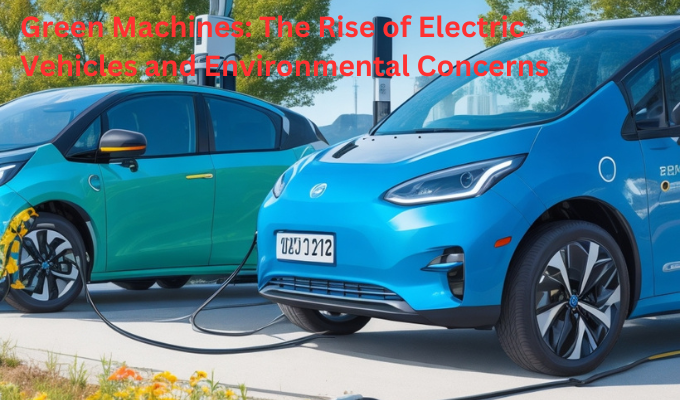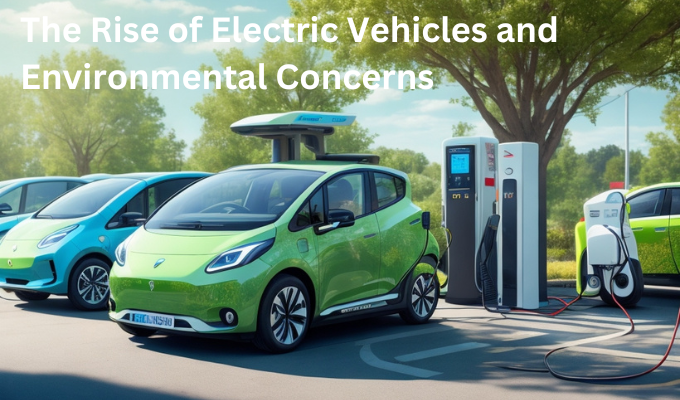Green Machines: The Rise of Electric Vehicles and Environmental Concerns
The automobile industry is undergoing a significant transformation with the rise of electric vehicles (EVs). These "green machines" are gaining popularity due to their environmental benefits and potential to reduce reliance on fossil fuels.
In this article, we will explore the growth of electric vehicles and the environmental concerns associated with their widespread adoption.
Table of Contents
1. The Evolution of Electric Vehicles
2. Benefits of Electric Vehicles
3. Environmental Impact of Electric Vehicles
- Reduced Carbon Emissions
- Air Quality Improvement
- Resource Consumption
4. Charging Infrastructure Challenges
5. Government Initiatives and Incentives
6. Electric Vehicles and Renewable Energy
7. Consumer Adoption and Awareness
8. Battery Technology Advancements
9. Electric Vehicles and Job Creation
10. Electric Vehicles vs. Internal Combustion Engines
11. Electric Vehicles and the Future of Transportation
12. Addressing Range Anxiety
13. Recycling and Disposal of Electric Vehicle Batteries
14. The Role of Electric Vehicles in Smart Grids
15. Conclusion
1. The Evolution of Electric Vehicles
Electric vehicles have come a long way since their inception. Early prototypes of electric cars were limited in range and performance. However, advancements in battery technology and charging infrastructure have paved the way for more practical and efficient electric vehicles.
2. Benefits of Electric Vehicles
Electric vehicles offer numerous advantages over conventional internal combustion engine (ICE) vehicles. They are environmentally friendly, reduce reliance on fossil fuels, and offer lower operating costs. Additionally, electric vehicles require less maintenance and provide a smooth and quiet driving experience.
3. Environmental Impact of Electric Vehicles
Reduced Carbon Emissions
One of the most significant environmental benefits of electric vehicles is their ability to reduce carbon emissions. EVs produce zero tailpipe emissions, leading to lower greenhouse gas emissions and improved air quality.
Air Quality Improvement
Electric vehicles have a positive impact on urban air quality. As they produce zero emissions, they help reduce air pollution and smog, resulting in healthier living environments.
Resource Consumption
While electric vehicles are greener on the road, their environmental impact extends to the manufacturing process. The extraction of raw materials for EV batteries and their subsequent disposal raises concerns about resource consumption and recycling.
4. Charging Infrastructure Challenges
The growth of electric vehicles is closely tied to the development of a robust charging infrastructure. The availability and accessibility of charging stations remain a challenge, particularly in some regions with limited charging infrastructure. However, efforts are underway to expand charging networks and establish fast-charging capabilities.
5. Government Initiatives and Incentives
To encourage the adoption of electric vehicles, governments worldwide have implemented various initiatives and incentives. These include tax credits, subsidies, and investments in charging infrastructure. These measures aim to make electric vehicles more affordable and convenient for consumers.
6. Electric Vehicles and Renewable Energy
The integration of electric vehicles with renewable energy sources presents a promising opportunity. By charging electric vehicles with clean and renewable energy, their environmental benefits can be further amplified. This synergy promotes a more sustainable transportation ecosystem.
7. Consumer Adoption and Awareness
Consumer awareness and education play a crucial role in the widespread adoption of electric vehicles. As people become more informed about the benefits and technology behind EVs, the demand for green machines continues to grow.
8. Battery Technology Advancements
Advancements in battery technology are crucial for the continued growth of electric vehicles. Research and development efforts focus on increasing battery capacity, reducing charging time, and improving overall performance. Breakthroughs in battery technology will address range limitations and enhance the driving experience.
9. Electric Vehicles and Job Creation
The rise of electric vehicles presents new employment opportunities. The manufacturing, installation, and maintenance of electric vehicles and charging infrastructure create jobs across various sectors. This shift towards cleaner transportation fuels economic growth and sustainability.
10. Electric Vehicles vs. Internal Combustion Engines
The comparison between electric vehicles and internal combustion engines reveals the advantages of EVs in terms of energy efficiency and reduced emissions. However, challenges such as charging infrastructure and battery technology still need to be addressed to make electric vehicles a viable alternative for all consumers.
11. Electric Vehicles and the Future of Transportation
Electric vehicles are poised to shape the future of transportation. As technology advances and becomes more affordable, it is anticipated that electric vehicles will become the norm rather than the exception. This transition will revolutionize the way we travel and contribute to a cleaner and greener world.
12. Addressing Range Anxiety
Range anxiety, the fear of running out of charge while driving, is a common concern among potential electric vehicle owners. However, with the development of longer-range batteries and the expansion of charging infrastructure, the issue of range anxiety is gradually diminishing.
13. Recycling and Disposal of Electric Vehicle Batteries
The recycling and disposal of electric vehicle batteries are important sustainability considerations. Proper recycling processes and the development of second-life applications for used batteries are crucial to minimize environmental impact and maximize resource efficiency.
14. The Role of Electric Vehicles in Smart Grids
Electric vehicles can play a significant role in the development of smart grids. By acting as mobile energy storage units, EVs can help balance electricity demand and supply, contribute to grid stability, and facilitate the integration of renewable energy sources.
15. Conclusion
The rise of electric vehicles brings promising opportunities for a more sustainable and environmentally friendly future of transportation. As technology evolves and awareness grows, the adoption of electric vehicles will continue to accelerate. However, challenges related to charging infrastructure, battery technology, and resource consumption must be addressed for electric vehicles to reach their full potential.
Frequently Asked Questions
1. Are electric vehicles more expensive than traditional vehicles?
- Electric vehicles can have a higher upfront cost, but they often offer lower operating costs and potential savings in the long run.
2. How long does it take to charge an electric vehicle?
- Charging times vary depending on the vehicle and the charging station. Fast-charging stations can charge an electric vehicle to 80% in approximately 30 minutes.
3. What is range anxiety?
- Range anxiety refers to the fear of running out of charge while driving an electric vehicle. It is a concern that can be mitigated through the expansion of charging infrastructure and advancements in battery technology.
4. Can electric vehicles help reduce air pollution?
- Yes, electric vehicles produce zero tailpipe emissions, contributing to improved air quality and reduced pollution in urban areas.
5. What is the lifespan of an electric vehicle battery?
- The lifespan of an electric vehicle battery varies depending on several factors, including usage patterns, temperature conditions, and battery chemistry. On average, electric vehicle batteries can last 8 to 15 years.


